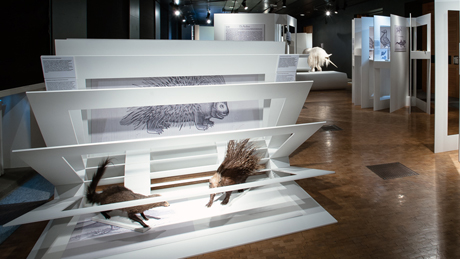Navigation auf uzh.ch
Navigation auf uzh.ch

Conrad Gessner was a structured yet unorthodox thinker. His unprecedented “Historia animalium” portrayed animals in all their facets: Aside from habitat, behavior, and physiology, he described their vices and virtues – from the busy bee to the selfless pelican. He addressed the God-given right of humans to use animals, from the hunt, to domestication and animal husbandry, not to mention the preparation of animals as food and medicine. An erudite scholar and practitioner, Gessner’s encyclopedia also examines the role of the animal kingdom in literature, art, proverbs, and fables.
The commemorative exhibition celebrates the 500th anniversary of Conrad Gessner’s birth and shows how the scholar applied an ingenious system to structure his extraordinary knowledge of the animal world. Modeling his work on Aristotle’s, Gessner divided the animal kingdom into four main categories: Quadrupeds, amphibians, birds, and fishes. He devoted one volume to each group, listed the animals in alphabetical order, and divided the information on each animal into eight subsections. “This combination of alphabetical order and structured portraits was an innovation that enabled scholars to find specific information quickly and easily within in a vast compendium and then compare it with the entries on various other animals,” says Lukas Keller, Director of the Zoological Museum of the University of Zurich.
In contrast to his contemporaries, Gessner’s aim was not only to critically examine historical works, but also to generate new knowledge. His approach was rigorous: “The scholar should gather all animal texts and drawings – both traditional and contemporary – and observe, dissect, describe, and illustrate the animals himself. This enables the critical examination and clarification of established and new learnings. Then, the scholar should recombine the enormous mass of knowledge and arrange it anew.”
With his detailed illustrations, Conrad Gessner set new standards in the depiction of animals. Comprising around 1,000 woodcuts, his magnum opus places as much value on illustrations as it does on text. Gessner was a keen observer who not only used illustrations from artists and other books: He also drew many animals himself; his blackbird – depicted with a small protruding feather and its beak open in song – stands out as exceptionally lifelike. Although he had no means to travel, Gessner maintained an impressive network. By sharing detailed search lists with his correspondents throughout Europe, he was able to amass valuable specimens, such as a lizard skin from an Italian trader and a toucan beak.
When Gessner commenced his great endeavor, the nascent discipline of zoology was at a crossroads between the traditions of classical learning and the development of scientific observation. In some entries of his encyclopedia, Gessner trusted his own judgment, in others he deferred to traditional teachings – as made evident by the unicorn in the exhibition. Indeed, the devout Gessner did not rule out the existence of the mythical beast: As the protagonist of many fables, the unicorn was thought to have a place in the divine plan. Of the 25 mythical creatures described in his work, he cast doubt on the existence of 21 of them, but confirmed the reality of the unicorn. It was not until many decades later that his specimen unicorn horn was accurately identified as the tooth of a narwhal.
The “Historia aminalium” was written in Latin with scholars in mind, and thus long found only in public libraries or in the collections of the wealthy. To increase sales and reduce the price, the bookmaker Froschauer, predecessor of the publishing house Orell Füssli, produced two standard-size illustrated books. Featuring a considerably abridged Latin text, the “Icones animalium” was more accessible and the illustrations more prominent. Thanks to rapid advancements in printing techniques and mass production, the dissemination of knowledge accelerated: Gessner’s illustration of the giraffe in the “Icones” found its way to China, where it appeared in an encyclopedia in 1725.